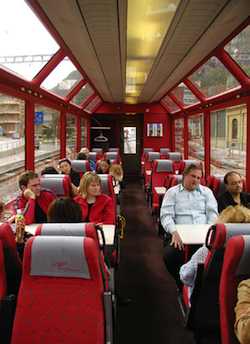- MENU
- HOME
- SEARCH
- WORLD
- MAIN
- AFRICA
- ASIA
- BALKANS
- EUROPE
- LATIN AMERICA
- MIDDLE EAST
- United Kingdom
- United States
- Argentina
- Australia
- Austria
- Benelux
- Brazil
- Canada
- China
- France
- Germany
- Greece
- Hungary
- India
- Indonesia
- Ireland
- Israel
- Italy
- Japan
- Korea
- Mexico
- New Zealand
- Pakistan
- Philippines
- Poland
- Russia
- South Africa
- Spain
- Taiwan
- Turkey
- USA
- BUSINESS
- WEALTH
- STOCKS
- TECH
- HEALTH
- LIFESTYLE
- ENTERTAINMENT
- SPORTS
- RSS
- iHaveNet.com: Travel
By Rick Steves

Riding the rails through Europe
Riding the rails through Europe, such as in this panoramic train car in Switzerland, offers a relaxed way to connect with traveling Europeans
When I travel, I still get a little rush when I settle into the right train. With each journey, I celebrate the joy of not having to drive. Riding the rails through Europe is less stressful, better for the environment, and just plain friendly -- offering a relaxed way to connect with traveling Europeans.
After all these years, my train travel still comes with a twinge of stress: Do I have enough time for a cup of coffee? Is my wristwatch in synch with the official station time? Would these locals really point me in the right direction? Am I on the right train?
But after I sit back in my seat, I reflect on the ease and comfort of European train travel. European trains go where you need them to go and are fast, frequent, and generally affordable (especially in the south). You can easily have dinner in Paris, sleep on the train, and have breakfast in Rome, Munich, or Madrid.
Learn your option and choo-choose what's best for your trip. I used a railpass on my first trip to Europe, and I still use them. With a railpass, you can travel virtually anywhere, anytime, often without reservations. Fast, international, or overnight trains are more likely to require reservations, but despite that chore, a railpass is still freedom on wheels.
Although the array of railpasses seems daunting, every pass has these features: It covers a specific geographical area (regional, country, or multiple countries); it has a fixed number of travel days; and it's either a consecutive-day pass or a flexipass (allowing you more flexibility to spread out your travel days).
Which type of pass is best? If you plan to travel nearly daily and cover a lot of ground, a consecutive-day pass is the right choice. If you like to linger for a few days at various places, a flexipass is the better option.
Most travelers prefer the flexipass. You have a certain number of travel days to use within a longer window of time (for example, any 10 days within a two-month period). You can sprinkle these travel days throughout your trip or use them all in a row.
Once you've planned a route for your trip, fine-tuning your actual "moving days" will help you zero in on the best pass for your trip -- and save you lots of money. (For all your options, see www.ricksteves.com/rail.) Here are some tips:
With careful juggling, a shorter pass can cover a longer trip. For example, you can take a one-month trip with a 21-day consecutive pass by starting and/or ending your trip in a city where you'd like to stay for several days or in a country not covered by your pass. On, say, a London/Rome trip, spend a few days in London, pay separately to take the Eurostar Chunnel train (not covered by any railpass) to Paris, sightsee in Paris for several days, then validate your consecutive-day pass when you leave Paris. Plan for your pass to expire in Rome, where you can easily spend a few days without the use of a railpass.
It can make sense to buy a longer pass for a shorter trip. One long train ride (for example, $250 first class from Florence to Paris) at the end of a 25-day trip can justify jumping from a 21-consecutive-day railpass to a one-month pass.
Stretch a flexipass by paying out of pocket for shorter trips. Use your flexipass only for those travel days that involve long hauls or several trips. If a particular day trip costs significantly less than your pass's per-day cost, pay out of pocket.
Point-to-point tickets can be a good budget option. Probably 10 percent of railpass travelers would have traveled more cheaply by buying tickets as they went. Point-to-point tickets are often your best bet in regions where rail travel is relatively cheap (such as Italy, Spain, and Eastern Europe) and for short travel distances anywhere.
You don't have to buy your tickets at the station. Arriving at the Venice train station during the 2010 Iceland volcano eruption, I saw something I've never seen before: a ragtag line of travelers stretching from the station all the way to the Grand Canal. They were waiting to book train tickets out of town.
These people were like refugees. They stood there for the better part of the day, trying to get out. But I dropped into a travel agency and, for a 3-euro fee, purchased my train ticket. Anyone can book tickets either online or from travel agencies ... and avoid the chaos at the station.
Sure, rail travel can be pricey. But if you've never experienced 21st-century rail travel (and you haven't, if your experience is limited to rail travel in the U.S.), you may find that it's about the best travel deal going.
© RICK STEVES DISTRIBUTED BY TRIBUNE MEDIA SERVICES, INC.
AUTOS | HOBBIES | EDUCATION | FAMILY | FASHION | FOOD & RECIPES | HOME DECOR | RELATIONSHIPS | PARENTING | PETS | TRAVEL | WOMEN
Travel | European Trains: Still a Great Way to Travel